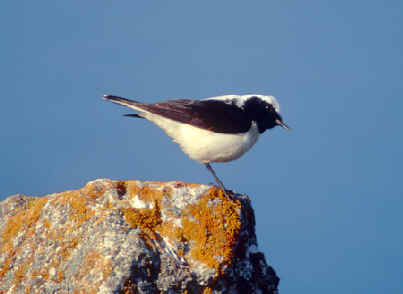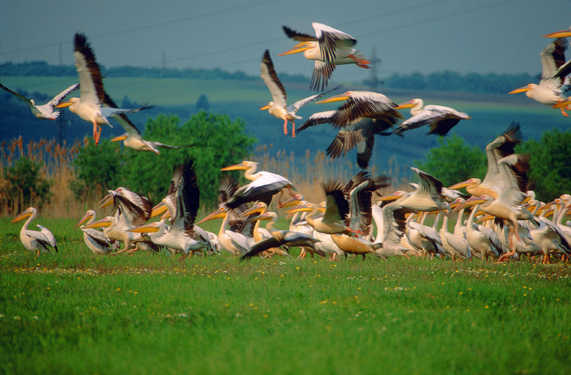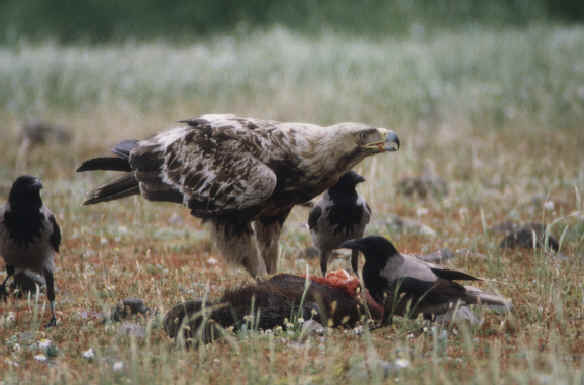 |
PO Box 9021,
Wilmington, DE 19809, USA
E-mail: font@focusonnature.com
Phone: Toll-free in USA 1-888-721-3555
or 302/529-1876 |
 Bulgaria Birds
Bulgaria Birds
during Focus On Nature Tours
1996 thru 2014
during the month of May
A l
ist compiled by Armas Hill
PHOTO AT RIGHT: PIED WHEATEAR
Over 270 birds have been found
during FONT tours in Bulgaria.
Codes:
(i): introduced species
(Vme): vagrant from the Middle East
The following 2 sets
of designations by Birdlife International:
(t): a globally threatened or
rare species
(t1): critical
(t2): endangered
(t3): vulnerable
(nt): a near-threatened species globally
(Ee): endangered in Europe
(Ev): vulnerable in Europe
(Er): rare in Europe
(Ed): has recently declined in Europe
(El): localized in Europe
Links:
Upcoming
FONT Birding & Nature Tours in Europe
List of Birds during FONT European Tours (with
some photos)
List of European Mammals

List of Birds during previous
Focus On Nature Tours in
Bulgaria:
- Great Crested Grebe ______
Podiceps c. cristatus
- Red-necked Grebe ______
Podiceps g. grisegena
- Black-necked Grebe ______ (called Eared Grebe in North America)
Podiceps n. nigricollis
- Little Grebe ("Dabchick") ______
Tachybaptus r. ruficollis
- European Shag ______
Leucocarbo (formerly Phalacrocorax) a. aristotelis
- Great Cormorant ______
Phalacrocorax c. carbo
- Pygmy Cormorant (nt) ______
Phalacrocorax pygmeus
- Great White Pelican (Er) ______ (IN
PHOTOGRAPH AT THE END OF THIS LIST)
Pelecanus onocrotalus
- Dalmatian Pelican (nt) (Ev) ______
Pelecanus crispus
- Grey Heron ______
Ardea c. cinerea
- Purple Heron (Ev) ______
Ardea p. purpurea
- Great Egret ______
Ardea
(formerly Egretta) a. alba
- Little Egret ______
Egretta g. garzetta
- Squacco Heron (Ev)
______
Ardeola ralloides
- Black-crowned Night-Heron
(Ed) ______
Nycticorax n. nycticorax
- Little Bittern (Ev) ______
Ixobrychus m. minutus
- Eurasian Bittern ______
Botaurus s. stellaris
- Glossy Ibis (Ed) ______
Plegadis falcinellus
- Eurasian Spoonbill (Ee) ______
Platalea l. leucorodia
- White Stork (Ev) ______
Ciconia c. ciconia
- Black Stork (Er) ______
Ciconia nigra
- Mute Swan (i) ______
Cygnus olor
- Whooper Swan ______
Cygnus cygnus
- Greylag Goose ______
Anser a. anser
- Greater White-fronted Goose ______
Anser a. albifrons
- Lesser White-fronted Goose (t3) (Ev) ______
Anser erythropus
- Red-breasted Goose (t3) (El) ______
Branta ruficollis
- Common Shelduck ______
Tadorna tadorna
- Ruddy Shelduck ______
Tadorna ferruginea
- Mallard ______
Anas p. platyrhynchos
- Gadwall (Ev) ______
Anas strepera
- Eurasian Teal ______ (has been considered conspecific
with the
Green-winged Teal
of North America)
Anas crecca
- Garganey (Ev) ______
Anas querquedula
- Northern Pintail (Ev) ______
Anas acuta
- Eurasian Wigeon ______
Anas penelope
- Northern Shoveler ______
Anas clypeata
- Red-crested Pochard (Ed) ______
Netta rufina
- Common Pochard ______
Aythya ferina
- Tufted Duck ______
Aythya fuligula
- Ferruginous Duck (nt) (Ev) ______ (has
also been called White-eyed Pochard)
Aythya nyroca
- Greater Scaup ______
Aythya m. marila
- Common Goldeneye ______
Bucephala c. clangula
- Osprey (Er) ______
Pandion h. haliaetus
- Red Kite ______
Milvus milvus
- Black Kite (Ev) ______
Milvus m. migrans
- Egyptian Vulture (Ee) ______
Neophron p. percnopterus
- Bearded Vulture (Ee) ______ (has
also been called Lammergeier)
Gypaetus barbatus
- Cinereous
Vulture (nt) (Ev) ______ (has also been called Eurasian Black
Vulture; another name: Monk Vulture)
Aegypius monachus
- Griffon Vulture (Er) ______
Gyps f. fulvus
- Levant Sparrowhawk (Er) ______
Accipiter brevipes
- Eurasian Sparrowhawk ______
Accipiter n. nisus
- Northern Goshawk ______
Accipiter g. gentilis
- Common Buzzard ______
Buteo b. buteo
- Long-legged Buzzard (Ee) ______
Buteo r. rufinus
- European Honey-Buzzard ______
Pernis apivorus
- White-tailed Eagle (nt) (Er) ______ (has also
been called White-tailed Fish Eagle)
Haliaeetus albicilla
- Short-toed Snake-Eagle (Er)
______
Circaetus gallicus
- Bonelli's Eagle (Ee) ______
Hieraaetus f. fasciatus
- Booted Eagle (Er) ______
Hieraaetus pennatus
- Golden Eagle (Er) ______
Aquila c. chrysaetos
- Asian Imperial Eagle (t3) (Ee) ______ (IN
PHOTOGRAPH AT THE END OF THIS LIST)
Aquila heliaca
- Lesser Spotted Eagle (Er) ______
Aquila p. pomarina
- Western Marsh-Harrier ______ (was considered conspecific with Eastern Marsh-Harrier, and when so,
was called Northern
Marsh-Harrier)
Circus a. aeruginosus
- Northern Harrier (Ev) ______ (has been
called Hen Harrier in Europe)
Circus cyaneus
- Pallid Harrier (Ee) ______
Circus macrourus
- Montagu's Harrier ______
Circus pygargus
- Saker Falcon (Ee) ______
Falco cherrug
- Peregrine Falcon (Er) ______
Falco p. peregrinus
- Eurasian Hobby ______
Falco s. subbuteo
- Red-footed Falcon (Ev) ______
Falco vespertinus
- Lesser Kestrel (t3) (Ev) ______
Falco naumanni
- Common Kestrel (Ed)
______
Falco t. tinnunculus
- Chukar (Ev) ______
Alectoris chukar kleini
- Grey Partridge (Ev)
______ (has also been called Hungarian Partridge)
Perdix p. perdix
- Common Quail (Ev) ______
Coturnix c. coturnix
- Common Pheasant (i) ______
Phasinus colchicus
- Water Rail ______
Rallus a. aquaticus
- Baillon's Crake (Er) ______
Porzana pusilla intermedia
- Spotted Crake ______
Porzana porzana
- Little Crake ______
Porzana parva
- Corncrake (t3) ______
Crex crex
- Common Moorhen
______
Gallinula c. chloropus
- Eurasian Coot ______
Fulica a. atra
- Grey Plover ______
(has been called Black-bellied Plover in the Americas)
Pluvialis s. squatarola
- Little Ringed Plover ______
Charadrius dubius curonicus
- Common Ringed Plover ______
Charadrius hiaticula tundrae
- Kentish Plover (Ed)
______ (was conspecific with Snowy Plover in North America & South America)
Charadrius a. alexandrinus
- Northern Lapwing
______
Vanellus vanellus
- White-tailed Lapwing (Vme) ______
(was called White-tailed Plover)
Vanellus (formerly Chettusia) leucura
- Ruddy Turnstone ______
Arenaria i. interpres
- Dunlin (Ev) ______
Calidris a. alpina
- Curlew Sandpiper ______
Calidris ferruginea
- Sanderling ______
Calidris a. alba
- Little Stint ______
Calidris minuta
- Temminck's Stint ______
Calidris temminckii
- Wood Sandpiper (Ed) ______
Tringa glareola
- Common Greenshank ______
Tringa nebularia
- Common Redshank (Ed) ______
Tringa t. totanus
- Spotted Redshank ______
Tringa erythropus
- Marsh Sandpiper ______
Tringa stagnatilis
- Green Sandpiper ______
Tringa ochropus
- Common Sandpiper ______
Actitis hypoleucos
- Ruff / Reeve ______
Philomachus pugnax
- Eurasian Curlew (Ed) ______
Numenius a. arquata
- Black-tailed Godwit (Ev) ______
Limosa l. limosa
- Eurasian Woodcock ______
Scolopax rusticola
- Common
Snipe ______ (was considered conspecific with the Wilson's Snipe of North
America)
Gallinago gallinago
- Red-necked Phalarope ______
Phalaropus lobatus
- Eurasian Stone-Curlew (Ev) ______
Burhinus o. oedicnemus
- Eurasian Oystercatcher ______
Haematopus o. ostralegus
- Pied Avocet ______
Recurvirostra avosetta
- Black-winged Stilt ______
Himantopus h. himantopus
- Collared Pratincole (Ee) ______
Glareola p. pratincola
- Slender-billed Gull ______
Larus genei
- Common Black-headed Gull ______
Larus ridibundus
- Mediterranean Gull ______
Larus melanocephalus
- Little Gull (Ed) ______
Larus minutus
- "Caspian (or Pontic)"
Yellow-legged Gull ______
Larus c. cachinnans
- Lesser Black-backed Gull ______
Larus fuscus graellsii
- Gull-billed Tern (Ee) ______
Gelochelidon (formerly Sterna) n. nilotica
- Caspian Tern (Ee) ______
Hydroprogne (formerly Sterna) caspia
- Sandwich Tern (Ed) ______
Thalasseus (formerly Sterna) s. sandvicensis
- Common Tern ______
Sterna h. hirundo
- Little Tern (Ed) ______
Sterna a. albifrons
- Black Tern (Ed) ______
Childonias n. niger
- White-winged Tern ______
Childonias leucopterus
- Whiskered Tern (Ed) ______
Childonias h. hybrida
- Parasitic
Jaeger ______ (has been called Arctic Skua in Europe)
Stercorarius parasiticus
- Common (or Feral) Pigeon (i) ______
Columba livia
- Stock Dove (or Stock Pigeon) ______
Columba oenas
- Common Wood Pigeon ______
Columba palumbus
- Eurasian Collared Dove ______
Streptopelia decaocto
- European Turtle-Dove (Ed) ______
Streptopelia t. turtur
- Great Spotted Cuckoo_____
Clamator glandarius
- Common Cuckoo ______
Cuculus c. canorus
- Eurasian Eagle-Owl (Ev) ______
Bubo b. bubo
- Long-eared Owl ______
Asio o. otus
- Short-eared Owl (Ev) ______
Asio f. flammeus
- Eurasian Scops-Owl (Ed) ______
Otus s. scops
- Little Owl (Ed) ______
Athene noctua indigena
- Eurasian Nightjar (Ed) ______
Caprimulgus europaeus
- Common Swift ______
Apus a. apus
- Alpine Swift ______
Tachymarptis (formerly Apus) m. melba
- Pallid Swift ______
Apus pallidus illyricus
- European Bee-eater (Ed) ______
Merops apiaster
- European Roller (Ed) ______
Coracias g. garrulus
- Eurasian Hoopoe ______
Upupa e. epops
- Eurasian Wryneck (Ed) ______
Jynx t. torquilla
- Black Woodpecker ______
Dryocopus martius
- Grey-headed Woodpecker
(Ed) ______
Picus c. canus
- European Green Woodpecker (Ed) ______
Picus v. viridis
- Syrian Woodpecker ______
Dendrocopos syriacus
- Great Spotted Woodpecker ______
Dendrocopos major pinetorum
- Middle Spotted Woodpecker ______
Dendrocopos m. medius
- Lesser Spotted Woodpecker ______
Dendrocopos minor hortorum
- Greater Short-toed Lark (Ev) ______
Calandrella b. brachydactyla
- Calandra Lark (Ed) ______
Melanocorypha c. calandra
- Wood Lark (Ev) ______
Lullula a. arborea
- Eurasian Skylark (Ev) ______
Alauda a. arvensis
- Crested Lark (Ed) ______
Galerida c. cristata
- Barn Swallow ______
Hirundo r. rustica
- Red-rumped Swallow ______
Cecropis (formerly Hirundo) daurica rufala
- Eurasian Crag-Martin ______
Ptyonoprogne rupestris
- Sand Martin (Ed) ______ (has been
called Bank Swallow in the Americas)
Riparia r. riparia
- Common House Martin ______
Delichon u. urbica
- Northern (or Winter) Wren ______
Troglodytes t. troglodytes
- Dunnock ______
Prunella m. modularis
- White-throated Dipper ______
Cinclus cinclus aquaticus
- Tree Pipit ______
Anthus t. trivialis
- Meadow Pipit ______
Anthus p. pratensis
- Water Pipit ______
Anthus s. spinoletta
- Red-throated Pipit ______
Anthus cervinus rufogularis
- Tawny Pipit (Ev) ______
Anthus c. campestris
- White Wagtail ______
Motacilla a. alba
- Grey Wagtail ______
Motacilla c. cinerea
- "Blue-headed" Western
Yellow Wagtail ______ (Western Yellow Wagtail
has been split from the Eastern Yellow Wagtail of eastern Asia & Alaska, Motacilla tschutschensis)
Motacilla flava flava
- "Grey-headed" Western Yellow Wagtail ______
Motacilla flava thunbergi
- "Black-headed" Western Yellow Wagtail ______
Motacilla flava feldegg
- Spotted
Flycatcher (Ed) ______
Muscicapa s. striata
- Collared Flycatcher ______
Ficedula albicollis
- Semicollared Flycatcher ______
Ficedula semitorquata
- Red-breasted Flycatcher ______
(was considered conspecific with what's now called the Taiga Flycatcher in eastern Asia)
Ficedula p. parva
- Whinchat ______
Saxicola rubetra
- Common Stonechat (Ed) ______
Saxicola torquatus rubicola
- Northern Wheatear ______
Oenanthe o. oenanthe
- "Eastern" Black-eared Wheatear ______
Oenanthe hispanica melanoleuca
- Isabelline Wheatear ______
Oenanthe isabellina
- Pied Wheatear ______ (IN PHOTOGRAPH AT BEGINNING OF THIS LIST)
Oenanthe pleschanka
- Black Redstart ______
Phoenicurus ochruros gibraltariensis
- Common Redstart (Ev) ______
Phoenicurus p. phoenicurus
- European Robin ______
Erithacus r. rubecula
- Common Nightingale ______
Luscinia megarhynchos bachrmanni
- Thrush Nightingale (or "Sprosser") ______
Luscinia luscinia
- Blue Rock Thrush (Ev) ______
Monticola s. solitarius
- Rufous-tailed Rock Thrush
(Ed) ______
Monticola saxatilis
- Eurasian Blackbird ______
Turdus m. merula
- Ring Ouzel ______
Turdus torquatus alpestris
- Song Thrush ______
Turdus p. philomelos
- Mistle Thrush ______
Turdus v. viscivorus
- Zitting Cisticola ______ (has
also been called
Fan-tailed Warbler, but a non-related species is so-named in Mexico;
additionally the cisticolas are now in a family apart from New World Warblers)
Cisticola j. juncidis
- Common Grasshopper Warbler ______
Locustella n. naevia
- Cetti's Warbler ______
Cettia c. cetti
- Savi's Warbler ______
Locustella l. luscinioides
- River Warbler ______
Locustella fluviatilis
- Marsh Warbler ______
Acrocephalus palustris
- Moustached Warbler ______
Acrocephalus m. melanopogon
- Eurasian Reed-Warbler ______
Acrocephalus scirpaceus
- Great Reed Warbler ______
Acrocephalus a. arundinaceus
- Sedge Warbler ______
Acrocephalus schoenobaenus
- Paddyfield Warbler ______
Acrocephalus agricola septimus
- Eastern Olivaceous Warbler (Ev) ______ (was
considered conspecific with what's now the Western Olivaceous Warbler,
Hippolais opaca)
Hippolais pallida elaeica
- Olive-tree Warbler (Er) ______
Hippolais olivetorum
- Icterine Warbler ______
Hippolais icterina
- Common Whitethroat ______
Sylvia c. communis
- Lesser Whitethroat ______
Sylvia c. curruca
- Garden Warbler ______
Sylvia b. borin
- Barred Warbler ______
Sylvia n. nisoria
- Eurasian Blackcap ______
Sylvia a. atricapilla
- Orphean Warbler ______
Sylvia hortensis
- Sardinian Warbler ______
Sylvia m. melanocephala
- Subalpine Warbler ______
Sylvia cantillans
- Willow Warbler ______
Phylloscopus trochilus acredula
- Western Bonelli's Warbler ______ (was
considered conspecific with what's now the Eastern Bonelli's
Warbler,
Phylloscopus orientalis)
Phylloscopus bonelli
- Wood Warbler ______
Phylloscopus sibilatrix
- Common Chiffchaff ______
Phylloscopus c. collybita
- Firecrest ______
Regulus i. ignicpillus
- Goldcrest ______
Regulus r. regulus
- Great Tit ______
Parus m. major
- Blue Tit ______
Cyanistes (formerly Parus) c. caeruleus
- Coal Tit ______
Periparus (formerly Parus) a. ater
- Marsh Tit ______
Poecile (formerly Parus) p. palustris
- Willow Tit ______
Poecile (formerly Parus) m. montanus
- Sombre Tit ______
Poecile (formerly Parus) lugubris anatoliae
- European Crested Tit ______
Lophophanes (formerly Parus) c. cristatus
- Long-tailed Bushtit ______ (has
been called Long-tailed Tit)
Aegithalos caudatus europaeus
- Eurasian Penduline-Tit ______
Remiz p. pendulinus
- Bearded Reedling ______ (was at
one time called Bearded Tit)
Panurus b. biarmicus
- Eurasian Nuthatch ______
Sitta europaea caesia
- Western Rock Nuthatch ______
Sitta n. neumayer
- Eurasian Treecreeper ______
Certhia f. familiaris
- Short-toed Treecreeper ______
Certhia b. brachydactyla
- Lesser Grey Shrike ______
Lanius minor
- Masked Shrike ______
Lanius nubicus
- Woodchat Shrike (Ev) ______
Lanius s. senator
- Red-backed Shrike (Ed) ______
Lanius c. collurio
- Eurasian Jay ______
Garrulus g. glandarius
- Spotted Nutcracker ______
Nucifraga c. caryocatactes
- Eurasian Magpie ______ (was considered conspecific
with the Black-billed Magpie of North America)
Pica pica
- Northern Raven ______
Corvus c. corax
- Rook ______
Corvus f. frugilegus
- Hooded Crow ______ (no
longer considered conspecific with the Carrion Crow)
Corvus cornix
- Eurasian Jackdaw ______
Corvus m. monedula
- Common Starling ______
Sturnus vulgaris
- Rosy Starling ______ (has
also been called Rose-colored Starling)
Sturnus roseus
- Eurasian Golden Oriole ______
Oriolus o. oriolus
- House Sparrow (i) ______
Passer d. domesticus
- Spanish Sparrow ______
Passer h. hispaniolensis
- Eurasian Tree Sparrow ______
Passer m. montanus
- Common Chaffinch ______
Fringilla c. coelebs
- European Goldfinch ______
Carduelis c. carduelis
- European Greenfinch ______
Carduelis c. chloris
- Eurasian Linnet ______
Carduelis c. cannabina
- Eurasian Bullfinch ______
Pyrrhula p. pyrrhula
- Hawfinch ______
Coccothraustes c. coccothraustes
- European Serin ______
Serinus serinus
- Red Crossbill ______ (called Red Crossbill in
North America)
Loxia c. curvirostra
- Corn Bunting ______
Emberiza (formerly
Miliaria) c. calandria
- Rock Bunting (Ev) ______
Emberiza c. cia
- Cirl Bunting ______
Emberiza cirlus
- Yellowhammer ______
Emberiza c. citrinella
- Ortolan Bunting (Ev) ______
Emberiza hortulana
- Black-headed Bunting (Ev) ______
Emberiza melanocephala
- Common Reed Bunting ______
Emberiza s. schoeniclus


A flock
of White Pelicans (above),
and an Imperial Eagle (below).

To
top of page


 Bulgaria Birds
Bulgaria Birds![]()

